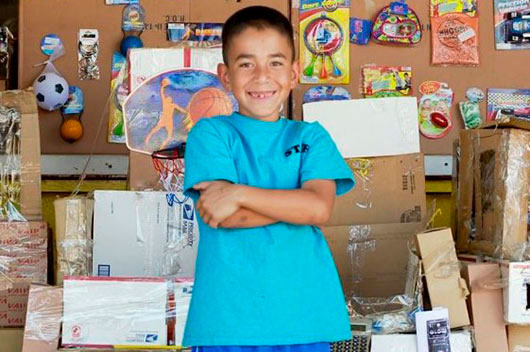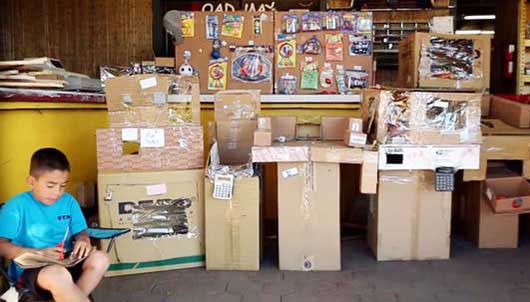
Is it possible that the parenting guru my generation so desperately needs is a dude who sells used car parts out of a store in East L.A.? Can it be that George Monroy with his goatee and receding hairline—who gave his 9 year-old some cardboard boxes, a pair of scissors, a really big packing tape dispenser and said to his son “Go!”—is a child-rearing genius?
It is possible. Because here is what a nine year-old named Caine Monroy did last summer vacation during the weekdays: nothing. He didn’t have summer camp, swimming lessons, soccer league, violin practice, a Mandarin tutor or anything that could even remotely be called an “enrichment activity.” He was not chauffeured around by his parents, babysitter or nanny on trips to a museum, to the zoo, or to any local historical sites of note. Other than what I suspect were several trips to Shakey’s Pizza and time spent in the Shakey’s Pizza arcade, this is how Caine Monroy spent a lot of his time last summer vacation: He played. And out of his unstructured playtime came the amazing, highly complex, wildly creative and now truly viral phenomena known as Caine’s Arcade.
Over 2.5 million Vimeo & YouTube views and $175,000 dollars later, this is what I think George Monroy—Caine’s dad—teaches us about modern parenting:
Read Related: 6 Life Lessons From Downton Abbey
Give kids some resources, but not too many.
George Monroy’s parenting reminds me of how I was raised by my old-school immigrant Latino parents: I was given enough things to spark my imagination, but not too much. My sister and I got ball gowns from thrift stores and played dress-up for hours. My sister actually made her own Barbie Dreamhouse out of cardboard. It had wallpaper (made out of wrapping paper) and wine goblets (made out of twisted tinfoil). It was awesome.
Caine was given space in the front of the store, markers, scissors and all the cardboard a kid could ever need or want. When Caine told his dad he “needed to buy” a claw machine, George challenged him to try and make one. And so he did. With blue yarn, an S-hook and yet another cardboard box, a DIY claw machine was born.
George did give Caine more resources when it became evident that Caine was clearly committed to his vision. We see no better proof of that than the calculators taped to each machine, which Caine uses to verify the fun passes using the “check mark button” known by math geeks everywhere as the square root symbol.
Give kids time. Lots of it.
This was, no doubt, the most precious gift George Monroy gave to his son Caine: largely unstructured, minimally supervised time. A regular question among my friends and I who have children is “What are you going to do with [insert kid’s name here] for the summer?” The assumption is that our children will have some type of ordered activity, program, or instruction during this free time. I have not tried it yet, but after watching this video, I am tempted to answer the question with something along the lines of “Oh, you know, the basics. Keep her safe. Fed. Clothed. That’s about it.”
By my calculation, Caine Monroy had about 280 hours of free time to kill last summer. And boy, did he make it count.
Give kids basic, clear rules.
The impression the video gives is that Caine was told three main things: Be safe. Stay at the front of the store. And let daddy work. Kids like some rules and basic structure—it gives them the sense that the world is an orderly place. Kids also do understand the unspoken implications of the rules, too. “Let daddy work” was code for “I am not here to entertain you. You will need to find ways to fight boredom on your own. Here is some cardboard for you to play with. Now get creative.”
Encourage kids to do what they like. Even if you think it is stupid. This way, they stay focused. And being focused and going deep are key.
I freely admit this here and now: If my 10-year-old had displayed a wild, passionate interest in video arcades, I would have tried to squash it. Had the interest proved persistent, I would have tried to channel it into what I deemed was an appropriate outlet, i.e. “Let’s go to the library to check out books about arcades! Yaaay!” Sir Ken Richardson, renowned scholar and advocate on the importance of creativity, indicts our entire educational system for this type of behavior that is done with the best of intentions, but has unintended consequences for ourselves and our children. “You were probably steered benignly away from things at school when you were a kid,” he said in his now famous TED talk. “Things you liked—on the grounds that you would never get a job doing that: ‘Don’t do music, you’re not going to be a musician. Don’t do art, you won’t be an artist.’ Benign advice—now, profoundly mistaken.”
This is why I was so impressed with George Monroy: There is not one bit of judgment in his voice when he says that Caine loves arcades. Instead of trying to encourage Caine to try and build other things with cardboard boxes, he encourages Caine to stick with what he knows and loves by encouraging his love of arcades. This is surely why Caine’s Arcade became more elaborate as time went on, with the tickets, the fun passes and the staff t-shirts. It is Caine’s focus and his attention to detail that make his Arcade so amazing. And it is his discipline in sticking with his original vision that is so wondrous.
Modern parenting sometimes feel like a race to expose your kids to as many things as possible. But sometimes a little bit of everything is a whole lot of nothing. Caine may not have known about viral video and the power of social media, but he had deep knowledge of arcades. He stayed focused on what he was building, going deep into things like pricing strategy (5 games for one dollar, 500 for two) and customer research (putting toy soldiers as goalies for his cardboard soccer game when he heard that it would be too easy to score a goal). Then Caine met someone who did know about viral video and the power of social media—LA based filmmaker Nirvan Mullick—and the rest became history.
And finally, the most important lesson of all: Get the Fun Pass.
It is a way better deal.
[youtube]http://www.youtube.com/watch?v=faIFNkdq96U[/youtube]












